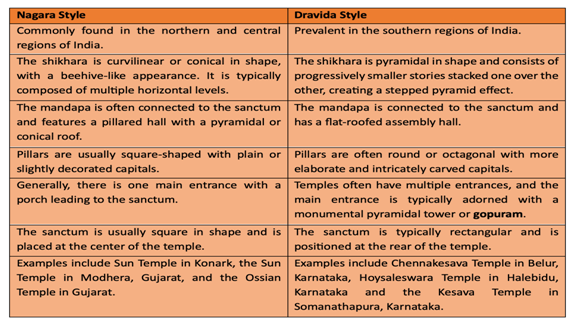Why in the News?
- The Ram temple in Ayodhya, Uttar Pradesh will be inaugurated on January 22.
- Chandrakant Sompura, 81, and his son Ashish, 51, have designed the complex in the Nagara style of temple architecture.
What’s in Today’s Article?
- About Nagara Style Architecture (Origin, Features, etc.)
- Comparison between Nagara & Dravida Style of Architecture
About Nagara Style of Temple Architecture:
- The Nagara Style of temple architecture emerged sometime in the 5th century AD, during the late Gupta period, in northern India.
- It is seen as a contemporary to the Dravida Style of architecture in southern India which too emerged in the same period.
- Temples classified as Nagara Style are found in Madhya Pradesh, Uttar Pradesh, Rajasthan, Gujarat, Odisha, Jharkhand, Bihar, Maharashtra, Andhra Pradesh (areas bordering Odisha) and West Bengal (southwest and Sundarbans areas).
- The sub-styles or schools are Orissa school, Chandel school and Solanki school.
Features of Nagara Style of Temple Architecture:

- The plan of a Nagara style of temple is four-sided.
- The garbhagriha is a perfect square whereas the whole temple plan could be oblong.
- The garbhagriha or sanctum sanctorum houses the image or idol of the main deity.
- The pathway leading to the garbhagriha is the mandapa where the worshipers accumulate to have darsana.
- In the early stage of temple construction, the roofs were flat.In the next stage of temple construction, the roof became pyramidal.
- This was the shikhara, a tall spire that tapered at the top.
- In the later stages, more additions were made to the temple complex.
- More mandapas were added and the garbhagriha was surrounded by a pradakshinapatha or a circumambulatory path.
- In some cases, gavaksa (windows) were added to allow cross ventilation for air and light.
- A Nāgara temple generally rests on a high platform- jagati over which is constructed a small platform called pitha.
- Rising above this is a smaller platform- adhisthana, which forms the base for the construction of superstructure of the temple.
- Among the other components of a Nagara temple are: bhadra, sirsa, amalaka, bijapuraka, rathika.
- When it comes to decorating the temples, the Nagara temples are intricately ornamented by carvings and sculptures.
- The entrance to the temple is highly decorated with images of gods and goddesses, floral and geometric designs.
- The bottom of the door frame depicts either dvarapalas or Ganga and Yamuna.
- On the walls and pillars of the temple, the sculptures and carvings depict devakanyas, apsaras, yaksas, yaksis, amalakas and floral garlands.
Key Differences between Nagara Style & Dravida Style of Temple Architectures:










